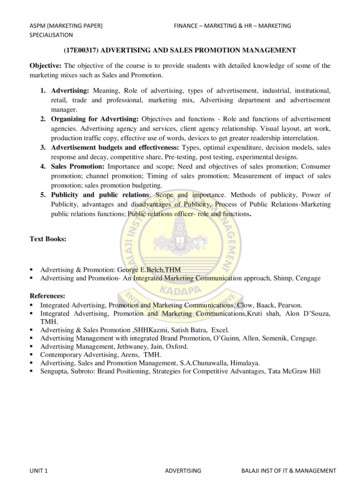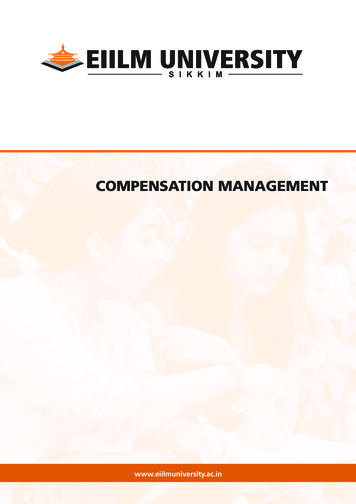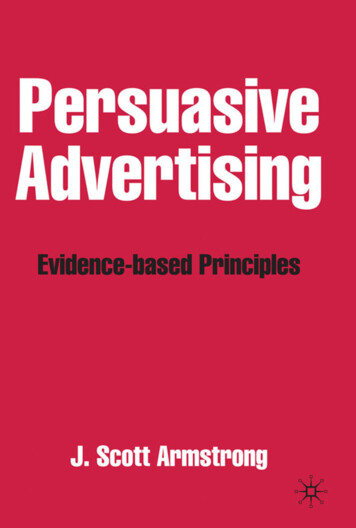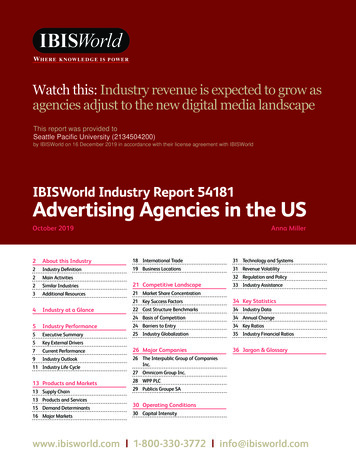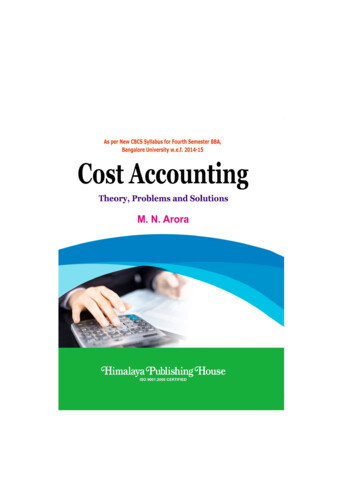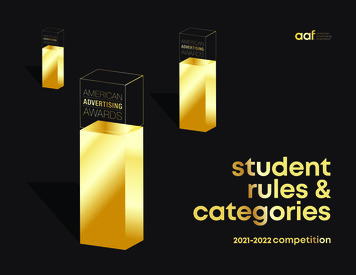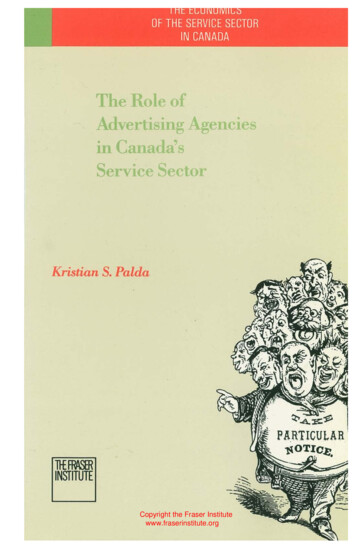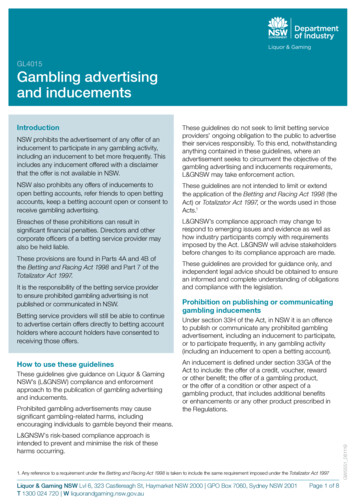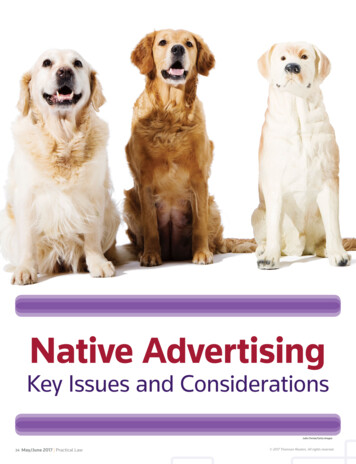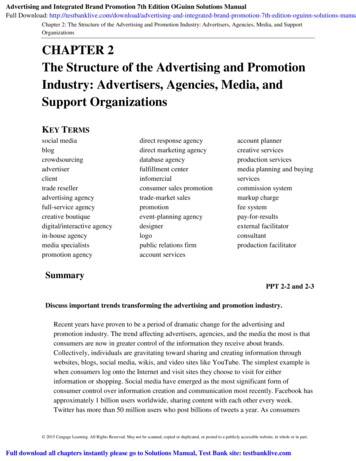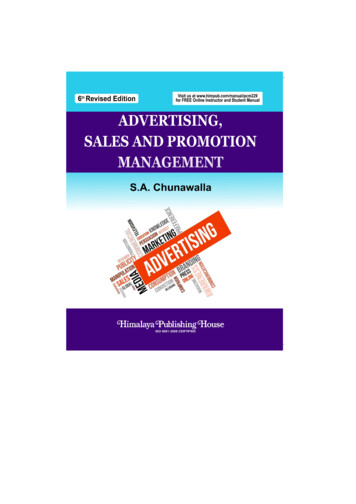
Transcription
ADVERTISING,SALES ANDPROMOTIONMANAGEMENT
ADVERTISING,SALES ANDPROMOTIONMANAGEMENTS.A. CHUNAWALLAB.Com. (Hons.), D. Pharma, MBA,Communication Consultant,Benzer, Mumbai - 400 103.Formerly, Faculty, Marketing,B.B.A. Programme,S.P. University, V.V. Nagar.e-mail: chunawalla@yahoo.com.Sixth Revised Edition: 2016MUMBAI NEW DELHI NAGPUR BENGALURU HYDERABAD CHENNAI PUNE LUCKNOW AHMEDABAD ERNAKULAM BHUBANESWAR INDORE KOLKATA GUWAHATI
AuthorNo part of this publication may be reproduced, stored in a retrieval system, or transmitted in any form or by any means, electronic,mechanical, photocopying, recording and/or otherwise without the prior written permission of the author and the publisher.First EditionReprintsSecond Revised EditionReprintsThird Revised EditionReprintFourth Revised EditionReprintFifth Revised EditionReprintSixth Revised Edition:::::::::::20012002, 200320052006, 20072008200920102011201320152016Published by: Mrs. Meena Pandey for Himalaya Publishing House Pvt. Ltd.,“Ramdoot”, Dr. Bhalerao Marg, Girgaon, Mumbai - 400 004.Phone: 022-23860170/23863863, Fax: 022-23877178E-mail: himpub@vsnl.com; Website: www.himpub.comBranch Offices:New Delhi: “Pooja Apartments”, 4-B, Murari Lal Street, Ansari Road, Darya Ganj,New Delhi - 110 002. Phone: 011-23270392, 23278631; Fax: 011-23256286Nagpur: Kundanlal Chandak Industrial Estate, Ghat Road, Nagpur - 440 018.Phone: 0712-2738731, 3296733; Telefax: 0712-2721216Bengaluru: No. 16/1 (Old 12/1), 1st Floor, Next to Hotel Highlands, Madhava Nagar,Race Course Road, Bengaluru - 560 001.Phone: 080-32919385; Telefax: 080-22286611Hyderabad: No. 3-4-184, Lingampally, Besides Raghavendra Swamy Matham, Kachiguda,Hyderabad - 500 027. Phone: 040-27560041, 27550139; Mobile: 09390905282Chennai: New-20, Old-59, Thirumalai Pillai Road, T. Nagar, Chennai - 600 017. Mobile: 9380460419Pune: First Floor, "Laksha" Apartment, No. 527, Mehunpura, Shaniwarpeth(Near Prabhat Theatre), Pune - 411 030. Phone: 020-24496323/24496333;Mobile: 09370579333Lucknow: House No 731, Shekhupura Colony, Near B.D. Convent School, Aliganj,Lucknow - 226 022. Phone: 0522-4012353; Mobile: 09307501549Ahmedabad: 114, “SHAIL”, 1st Floor, Opp. Madhu Sudan House, C.G. Road, Navrang Pura,Ahmedabad - 380 009. Phone: 079-26560126; Mobile: 09377088847Ernakulam: 39/176 (New No: 60/251) 1st Floor, Karikkamuri Road, Ernakulam, Kochi - 682011,Phone: 0484-2378012, 2378016; Mobile: 09344199799Bhubaneswar: 5 Station Square, Bhubaneswar - 751 001 (Odisha).Phone: 0674-2532129, Mobile: 09338746007Indore: Kesardeep Avenue Extension, 73, Narayan Bagh, Flat No. 302, IIIrd Floor,Near Humpty Dumpty School, Indore - 452 007 (M.P.). Mobile: 09301386468Kolkata: 108/4, Beliaghata Main Road, Near ID Hospital, Opp. SBI Bank,Kolkata - 700 010, Phone: 033-32449649, Mobile: 09883055590, 07439040301Guwahati: House No. 15, Behind Pragjyotish College, Near Sharma Printing Press,P.O. Bharalumukh, Guwahati - 781009, (Assam).Mobile: 09883055590, 09883055536DTP by: HPH, Editorial Office, Bhandup (Rajani Tambe)Printed at: Geetanjali Press Pvt. Ltd., Kundanlal Chandak Industrial Estate, Ghat Road, Nagpur - 440 018.
PREFACE TO THE SIXTH REVISED EDITIONWe are in an ICE age, i.e., the age of Internet, Communication and Entertainment.There is great convergence of media and communication now. Advertising so far usedthe traditional mass media and was called mass communication. We are slowly shifting todigital advertising on internet sites where advertisements are related to customer likesand dislikes, his surfing habits, search habits and shopping habits. The matching isdone by an algorithm. This is personalised communication. We have covered these changesin this book. At the same time, the other elements of communication mix such as DirectMarketing, PR, word-of-mouth and SP are also covered. We have covered in detailpersonal selling and sales management. Kindly read the blog www.marketingganga.comfor further improvement of your concepts. All suggestions and comments are welcome.— Author
PREFACE TO THE SECOND REVISED EDITIONIndia can proudly boast of world-class business schools such as IIMs, but is woefullyshort of world-class study material in different areas of management relevant to Indianconditions. This book is a bold attempt to present first-rate literature on Advertising, Salesand Promotion Management in crisp and concise manner without sacrificing the significantcontents while doing so. Since the first edition of the book met with spectacular success, therewas an opportunity to revise the text for the second edition. The contents have beenenriched, especially the media-related material which now carries a small lexicon ofmedia-specific terms.The book is replete with suitable caselets and examples to facilitate the understanding of the subject.Several academic institutions have found the book very useful, and have providedvaluable feedback to improve the book, which we gratefully acknowledge.The book is an integrated approach covering the elements of promotion mix such asadvertising, sales promotion, publicity and PR. The ultimate aim is to market the productto the target audience. Sales is the end-product of marketing; and is a negelectedfunctional area in the curriculum. The essential aspects of sales management aretreated adequately in this book.Readers are requested to communicate their comments to the author atchunawalla@yahoo.com.— Author
CONTENTS1. Basic Concepts of Promotion and Communication1 - 122. Fundamentals of Advertising13 - 243. Advertising as a Career25 - 324. Advertising Research33 - 385. Marketing and Advertising Planning39 - 566. Advertising Agency57 - 657. Market Analysis: Segmentation and Targeting66 - 798. Creativity, Creative Strategy and Copywriting80 - 1099. Art Direction110 - 12210. Media Planning123 - 13111. Print Media132 - 13612. Electronic Media: TV — The New Golden Goose137 - 14713. Electronic Media: Radio148 - 16114. Outdoor and Transit Media162 - 16915. Media of the New Millennium — Internet170 - 17816. Advertising Regulation179 - 18317. Word-of-Mouth Advertising184 - 18618. Direct Marketing187 - 20219. Sales Promotion203 - 21420. Public Relations215 - 23721. Nature and Scope of Sales Management238 - 24122. Sales Management, Personal Selling and Salesmanship242 - 25523. Personal Selling Objectives256 - 26424. Personal Selling Strategy265 - 27025. The Job of a Sales Manager271 - 274
26. Sales Organisation275 - 28027. Personnel Management in the Selling Field281 - 28528. Recruiting Sales Personnel286 - 28829. Selecting Sales Personnel289 - 30630. Sales Training307 - 31231. Execution and Evaluation of Sales Training Programmes313 - 31632. Motivation and Morale of Salespersons317 - 32533. Compensating Salespersons326 - 34134. Management of Sales Expenses342 - 34635. Sales Meetings and Sales Contests347 - 35436. Controlling Salespeople — Evaluation and Supervision355 - 36037. Sales Budget361 - 36438. Sales Quotas365 - 36839. Sales Territories369 - 37240. Sales Control and Cost Analysis373 - 375
1BASIC CONCEPTS OFPROMOTION ANDCOMMUNICATIONA marketer manages a marketing mix of four variables – products, price, promotion and place. In this book, we shallexamine the element of promotion in detail. Mostly, people equate promotion with advertising but it is just one promotionaltool used by a marketer.What is promotion? It is the communication package in marketing which aims to exchange information between buyersand sellers. Beyond informing, it also accomplishes the task of reminding and persuading the consumers so that theyrespond to the product or service being offered.The whole field of promotion management is quite interesting and challenging. Just put yourself in the position of apromotional manager of Pfizer in the process of developing a campaign of advertising – addressing the doctors to promotetheir new antibiotic. Alternatively, imagine yourself as the sales manager of Hindustan Unilever who has to decide aboutrecruiting and selecting the salesmen for their diverse products, training them and evaluating them. Perhaps, you can alsoconsider how you as a general manager of Shoppers’ Stop would design a sales promotion campaign for your customers bywhich they will be induced to buy and buy more. Promotion as you will appreciate is a dynamic activity. In this book, thewhole gamut of the promotional process has been covered.COMPONENTS OF PROMOTIONThere are four broad promotional tools available to a marketer: Advertising which is any paid form of non-personal presentation of ideas, goods or services by an identifiedsponsor in a media-mix. Personal-selling is an oral presentation made to prospective customers so as to generate sales. It is just a coversationwith a purpose. Sales Promotion are those marketing activities excluding advertising, personal selling and publicity which stimulateconsumer purchasing, dealer and salesperson’s effectiveness. It is a short-term activity. Publicity and Public Relations stimulate demand in a non-personal way. Public relations maintain effective relationsof the organisation with different publics like employees, customers, shareholders, suppliers, dealers, government,media and so on. Public relations put commercially significant news in media or gets a favourable coverage onradio, television or stage. As media costs of this promotion are not paid for by the sponsor, it is called publicity.James Engel, Hugh Wales and Martin Warshaw define publicity as “any form of non-paid commercially significantnews or editorial comment about ideas, products and institutions”. (Promotional Strategy, Homewood R.D. Irwin,1971, p.3). Public relations is extremely effective in influencing a target audience by building credibility.
2Advertising, Sales and Promotion ManagementThe combination of these four methods of promotion is called promotional mix of an organisation. The ultimate aim isto communicate a message to an audience so as to get a response – either an attitude change or purchase.Apart from the above promotional mix, a new discipline has emerged. It is called direct marketing which uses the abovepromotional components in a special manner. We have also covered the principles of direct marketing in this book.Advertising – A Tool of CommunicationAdvertising has evolved since the Industrial Revolution as a tool of marketing communication. It transmits an effectivemessage from the marketer to a group of individuals. The marketer, as we have observed already, pays for sponsoring theadvertising activity. Advertising unlike salesmanship which interacts with the buyer face-to-face, is non-personal. It isdirected at a mass audience, and not at an individual, as in personal selling.Though marketers use advertising to promote products and services, it is a communication tool. The advertiser is thesource transmitting the message. The message is conveyed through an appropriate medium such as the press, TV, or the Net.The message is decoded by the target audience who receives it. The ultimate aim of advertising is to make the target audiencefavourably inclined towards the product or service. In this sense advertising is marketing communication. As it is received bya large number of people, through the mass media, it is called mass communication.Advertising aims at drawing attention to a product. It seeks to create an awareness about the existence of the advertisedproduct. It passes on information about the product in such a way that interest is created in the mind if the prospectiveconsumer about the product. Then there is a growing desire to possess the product. There are convincing arguments infavour of the product. All this leads us to a buying inclination or buying action.Let us first understand the total communication plan of an organisation.COMMUNICATION PLANMostly organisations treat advertising, sales promotion, public relations, publicity and direct marketing as separateactivities. However, we must integrate them together and the whole communication package that emerges must be integratedto other elements of the marketing mix and personal selling. Strategic business plan is the starting point which generates astrategic marketing plan. Communication plan or promotional plan is subservient to the marketing plan.The figure 1.1 explains this in a schematic fashion.Strategic Business PlanStrategies to move us from where weare to where we would like to be.Marketing PlanObjectives to realise these strategies.Communication Promotional PlanAdvertisingSales PromotionObjectives of each activity.PR and PublicityDirect MarketingProgrammesand BudgetReview andEvaluateFigure 1.1: Communication PlanningPersonal SellingDetailed plans andbudget allocationResults measured andcompared
Basic Concepts of Promotion and Communication3COMMUNICATION MIXLet us now be clear about the relationship of advertising with other elements of communication mix.Advertising and Personal SellingAdvertising communicates with a large number of consumers through the mass media such as press and TV. Advertising is mass communication and is non-personal. We address the buyers through the media by putting paid for messages.There is no face-to-face conversation. Personal selling, on the other hand, is personal communication. Here the salesmantalks with a prospective buyer – it is a person-to-person talk. Personal selling is thus individual communication and not masscommunication. These days there is mass production and it is meant for mass consumption. It is costlier and difficult tocontact each individual buyer. Advertising is an economical mass communication tool available to a marketer. However, thereare products which can be sold better by personal selling, e.g., complex machinery, capital goods. The salesman is in a betterposition to explain the features of the product to the buyer for industrial products. Even for simpler products, salespeople cansupplement advertising effort. Salespeople can tailor their sales talk to the needs and personality of each buyer. It is verydifficult to measure the effectiveness of advertising. However, a salesman receives immediate feedback from the buyer. Thesalesman can tune his message to the buyer accordingly.Personal selling is very intense. An advertisement can be skipped, but it is difficult to dismiss a salesman summarily. Itis very inefficient for mass market products. Advertising scores over personal selling for such products.Advertising and Sales Promotion (SP)Advertising makes people favourably inclined towards a product or service or idea. This may lead to its buying later.Sales promotion takes over from this point. It provides a direct inducement to the consumer to go in for the buy – a discount,price off, coupon, etc. Advertising informs people, reminds them and persuades them to buy. Its approach is indirect. Itattempts to build the brand in the long-term. Sales promotion (SP) is a direct short-term approach and expects immediateresponse in terms of buying action. Sales promotion is not a continuous activity. Advertising, in comparison, is more frequentand repetitive. Sales promotion supplements advertising and personal selling. At the point of sale, sales promotion works outbetter and fast. Displays and contests are effective tools of sales promotion.Advertising and PublicityPublicity is also non-personal like advertising. It also stimulates demand for the product/service/organisation. It consistsof planting commercially significant news in print media, or obtaining favourable presentation on air or stage. Publicity is notpaid for by the sponsor. There are two importnat distinctions — publicity is not openly paid for and the presentaion is notprogrammed. Marketers have less control over publicity than they have on advertising. Publicity is left to the discretion of themedia. It could be negative or positive.Advertising and Public Relations (PR)Public relations have one ultimate aim – to develop a favourable image of the organisation and its offerings in the eyes ofthe public. The various sections of the public are customers, suppliers, employees, governments, local bodies, pressuregroups, media, society at large. PR can be formal or informal. Unlike advertising, it is personal. PR aims at establishing andmaintaining understanding between an organisation and its public. PR is low-cost as compared to advertising. One of theimportant functions of PR is media management. PR is also of great help in crisis management. PR indirectly helps thecompany to sell its products by building a good corporate image of the company. But PR cannot replace advertising. PR doesthe ground work for advertising. Product and service must support the PR effort. Advertising has a greater role in sellingtangible products. PR has a greater role in selling intangible products like services. PR is slowly evolving into an integratedapproach called corporate communications. Corporate communications cover corporate identity programmes, re-imaging,media relations, corporate advertising, sponsorships, communications during takeovers, communications prior to an IPO,corporate philanthropy and crisis management.
4Advertising, Sales and Promotion ManagementDEFINITION OF ADVERTISINGAdvertising is defined as the paid, non-personal form of communication about products or ideas by an identifiedsponsor through the mass media so as to inform, persuade or influence the behaviour of the target audience.Advertising is directed to a large number of people and not to one individual. That is why we call it non-personal.Advertising is communication about products or ideas. It may inform us about the features of iPod or new smart phone orspell out the need to have a cancer check-up. An identified sponsor is the advertising company or an NGO soliciting donations.Themass media channels are the newspapers, magazines, radio, TV which carry the advertised message so that it reaches thepeople at once. The advertising message either informs about the product or persuades people to buy it. It may influence themto vote for a specific candidate. Sometimes, the message may influence us not do certain things, say drug abuse or wastageof fossil fuels.The simplest definition of an advertisement is that it is a ‘public announcement’. In earlier times to ‘advertise’ wasmerely to announce or inform. Some ads such as the ‘classifieds’ still do the same – announce the birth, death, engagementswith little or no intention to persuade. Gradually, advertising evolved as a form of persuasive communication with the public.In a free market economy, such communication is required to make intelligent choices. John E Kennedy, Lord and Thomas AdAgency, described advertising as ‘salesmanship in print’. Albert Lasker endorses the same definition. Till the term ‘salesmanship in print’ was coined, advertising was, viewed as information dissemination. Salesmanship added a new dimension to theadvertising process – that of persuasive skills of a salesman. It introduced the art of persuasion and made advertising a forceto reckon with. Sidney Bernstein (1990) reinforces Kennedy’s definition by describing ‘advertising as a subsitute for thehuman salesman’. Chris Jacques, chairman, BBDO Asia-Pacific thinks that advertising is the business of creative thinking forcommercial advantage.The following two definitions of advertising are also interesting:Advertising is the foot on the accelerator, the hand on the throttle, the spur on the flank that keeps our economy surgingforward.– Rober W. Sarnoff (1956)Prasoon Joshi, Creative Director, South and South-east Asia, McCann Erickson asserts that as advertisers, we are in thecommunication business. Clients come to advertising agencies, though they can give a technical brief, to communicate theirmessage in a consumer-friendly manner. The crux of advertising is effective communication. People who cannot communicate should not get into this business.Advertising is one of the important forces which serve the public interest. It is a form of open communication betweenthose who sell and those who buy. It is a form of advocacy – open to any company or cause that wants to argue its case. Thejury is the public. Every purchase is a vote. Burt Manning, JWTMARKETING COMMUNICATIONSBroadly speaking, marketing communciation is a continuous interaction between the buyers and sellers in a marketplace. Thus, any gesture or act that helps to attract buyers and satisfy their needs is marketing communication. However,to a marketer, marketing communication is the process of presenting an integrated set of stimuli to a target with an intentof evoking a desired set of responses within that target market and setting up channels to receive, interpret and act uponmessages and identifying new communication opportunities.Let us now examine the communication process.COMMUNICATION PROCESSIn communication process, there is a transmission of message from a sender to the receiver. The end result of thecommunication process is the understanding of the message. The message is transmitted through media or certain channels.The response to the message is known through the feedback from the receiver of the message. The communication sometimes fails to accomplish its purpose — creation of an appropriate response or understanding when the message is distortedby ‘noise’ elements. A sender encodes the message, whereas the receiver decodes the message. The whole process can beillustrated with the help of a diagram.
5Basic Concepts of Promotion and CommunicationSource’s field ofexperienceSourceEncodingReceiver’sfield of erResponseFeedbackFigure 1.2: Communication ProcessThe sender is called the source of the message. The encoding could be in the form of a letter or advertising copy. Themessage is carried by the media, e.g., post and telegraphs department or TV or press. The message is a received by thereceiver who responds to it, which is then communicated back to the source. The message must arrest the attention of thereceiver, be understood and stimulate the needs of the receiver and suggest methods to satisfy these needs.It is important for the senders to know the receivers or audiences they would like to reach and the responses theyexpect. The skill lines in the proper ecoding of the message. It should anticipate how the message would be decoded at thereceiving end. As the ultimate success of communication is the understanding of the message to know as much as possibleabout the receiver. The media chosen too must be efficient. The feedback channels are established it to necessary for thesender to know the response. In this process noise variables may distort the effectiveness of the communication. Noiseincludes poor planning of the message, busy audience members or careless feedback mechanism.The common field of experience and reference makes the communication possible. It there is no such overlap, communication may be poor or impossible. The feedback comes as marketing research inputs or sales reports. The noise elementsare the competitive promotional messages. Communication can be made more effective by understaning the audience and themarket properly. Marketing communication is a major chunk of the total corporate communications. Advertising is an important element of the marketing.MARKETING COMMUNICATIONAfter examining the basic communication process, we shall understand the marketing communication concept. Marketing is the process which brings the products and services to the consumers to satisfy their needs and wants. Modernmarketing manages the four Ps of product, promotion, price and place or the channel of distribution. The whole marketingprocess in a sense has a large communication content. For instance, the product communicates prestige youthfulness, speed,care, etc. The brand name communicates the product attributes, e.g., Dreamflower talc. The package communicates convenience coupled with aesthetics. The price communicates the quality of the product. The marketer and distributor communicate between them. Thus each elements of the marketing mix either facilitates or hinders communication process. Theseelement greatly influence the selling process. Marketing communication is thus a broader term. However, in a narrow sense,sense, marketing communication is the promotional or strategy. It is planned promotional communication with a mix of fivemajor tools —Advertising: Any paid from of non-personal communication of products, services and ideas by an identified sponsor.Sales Promotion: Short-term direct inducements to the consumers, salespeople distributors to stimulate the sales ofproducts and services.Publicity: Putting commercially significant news in the media, it is not directly paid for.Personal Selling: A sales force is maintained to approach the prospects, interact with them, make a sales presentationand close the sale. It is one-to-one communication.Public Relations: Public relations project a favorable image of the organisation in the public.
6Advertising, Sales and Promotion ManagementMarketing Communication ProcessThe marketing communication process is illustrated in the following diagram.Noice The sender of the message is the marketer. The message is encoded as advertising copy, publicity material, salesdisplays or sales talk. The media to deliver the message could be print media such as press/magazines, or electronic such asradio/TV/films or a salesman making a sales talk. The decoding involves the interpretation of the message by the consumers.This is the most challenging part of the marketing communication, as the consumer may not always interpret the message asthe marketer desires it to do. The fundamental difficulty arises in communication at the stage of coding and decoding. Thisresults from the differentces in interpreting the meanings of different words/symbols. There may be different frames ofreferences and field of experience between the sender and the receiver. This is illustrated in the following diagram.Marketing Communication Advertising has certain unique features, which distinguish it from other froms of marketingcommunication such as personal selling, sales promotion (SP) publicity and public relations (PR).We give a table 1.1 below to make you understand the role played by each player in the process of communication:Table 1.1 : Communication Process in EssencePlayerRemarksSender(Source)He is the originator of communication.His communication objectives must be clear.He must understand the field of experience and frame of references of his receiver.He has to consider the readiness of the receiver to receive the communication. He could be a salesperson,advertisement or coupon.MessageIt should be true to the contents of the communication emerging from the sender. It must be soworded that the receiver is able to decode it. The process of arranging the message, in words and pictures is calledencoding.MessagechannelsOnce there is a choice, a channel or a channel mix that is most effective must be chosen. The channel can bethe spoken word (personal selling) or the mass media (advertising).ReceiverThe communciation must reach him. He must be prepared to receive the message. He is thetarget of communication. On the delivery of message, the receiver attempts to interpret the mesage. It is called decoding.FeedbackIt completes the cycle of communication. It establishes for the sender that the message has been receivedand understood the way he wanted it to be received and understood. It is the part of the overall responsethat is measured by the sender.To facilitate communication, the source and the receiver must share a common background, social influences andneeds. When these overlap, it is called overlapping of psychological fields. The larger the mutually shared field, the greater thechance of effective communication.After understanding the message, the receiver responds to it. This response could be a positive or negative attitude, aphysical gesture or a purchase.AIDA COMMUNICATION MODELMarketing communication especially, advertising is directed towards a group of users of the products/services. Thisgroup is called the target audience of the product services. A marketer has to identify its target audience, and the response heexpects from it. The ultimate response is of course, the buying of the product/service. We must learn the stages throughwhich the target audience passes before the readiness-to-buy stage is reached.
Basic Concepts of Promotion and Communication7The effectiveness of advertising depends upon the extent to which the advertising message is received and accepted bythe target audience. Effective advertising goes through the stages of: (i) attracting attention, (ii) arousing interest, (iii) creatingdesire for the products, (iv) and finally leading to action on the part of the audience. All advertisment do not succeed on allthese counts. This is one reason behind the great divergence between the number of people exposed to the advertisement andthose who ultimately decide to buy the product. At the buying-readiness stage, other elements of marketing mix, especiallydistribution become crucial.The AIDA model describes the sequence of events which must take place between the receipt of the message anddesired action.In AIDA model, A stands for attracting attention, I for arousing interest, D for creating a desire and A for obtainingaction.Advertising as a communication medium in most cases-effectiv perform the first three functions. In case of directaction advertising, it also translates desire into action unaided by other promotional instruments. In case of indirect-actionadvertising, however, the action of buying is facilitated by two-way communication between the intending buyer and the salesstaff.Let use examine the attention, interest, desire and action components in more deta
Personnel Management in the Selling Field 281 - 285 28. Recruiting Sales Personnel 286 - 288 29. Selecting Sales Personnel 289 - 306 30. Sales Training 307 - 312 31. Execution and Evaluation of Sales Training Programmes 313 - 316 32. Motivation and Morale of Salespersons 317 - 325 33. Compensating Salespersons 326 - 341 34. Management of Sales .
